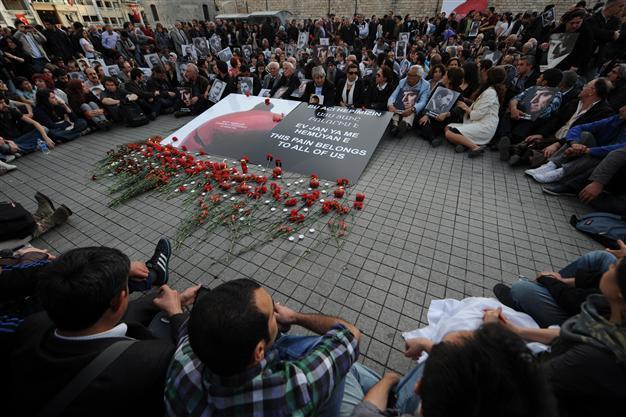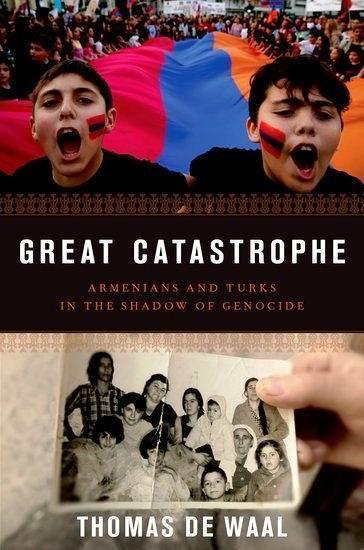Armenians and Turks in the shadow of 1915
William Armstrong - william.armstrong@hdn.com.tr
 ‘Great Catastrophe: Armenians and Turks in the Shadow of Genocide’ by Thomas de Waal
‘Great Catastrophe: Armenians and Turks in the Shadow of Genocide’ by Thomas de Waal
(Oxford University Press, 312 pages, $29.95)In his annual address on the subject every April 24, U.S. President Barack Obama has taken to referring to 1915 as the “Meds Yeghern,” which is Armenian for “Great Catastrophe.” This linguistic sleight of hand artfully sidesteps the word “genocide,” and gives the name to this book by Thomas de Waal, a Senior Associate at the Carnegie Endowment for International Peace. The choice of title is deliberate, as excavating in detail what happened in 1915 is not de Waal’s main aim. Rather, his focus is on tracing the fraught relations between Armenians and Turks in the century since.

He knows that he is stepping onto a minefield. As the late Turkish Armenian journalist Hrant Dink wrote in 2004, “Turks and Armenians and the way they see each other constitute two clinical cases: Armenians with their trauma, Turks with their paranoia.” Such is the subject matter, de Waal is guaranteed to annoy some people on either side, but his book is sensitively judged - conversant in all the arguments, sympathetic to all perspectives, and full of interviews. It includes plenty of interest to both specialists and non-specialists.
Those non-specialists might assume that relations between Turks and Armenians have been stubbornly unchanging since 1915 - like two rutting stags locking horns and refusing to budge for 100 years. But as de Waal makes clear throughout the book, the dispute has in fact gone through a series of phases and there were many surprising episodes on the road to the current impasse.
Public debate in the decades immediately after 1915 was relatively subdued. “The Armenian question fell into a kind of historical abyss,” de Waal writes. The quotation ascribed to Hitler, “Who now remembers the Armenians?” is almost certainly apocryphal, but it does indicate the international amnesia over the issue from the 1920s to the 1950s. At the time, Armenians in the diaspora were more preoccupied with the enormous “fratricidal feud” over the Soviet Union and the status of Soviet Armenia than they were with Turkey.
De Waal provides a fascinating account of this abeyance period, including the years immediately after the First World War, when Armenians and Azerbaijanis continued to fight in the already ravaged bloodlands of the South Caucasus. This grim period of mutual atrocities is under-examined elsewhere, but it was another arena of the bloody violence and ethnic cleansing that characterized everywhere from Trieste to Baku from 1912 to 1922, leaving behind homogenous or majority-dominated national entities. Also fascinating is the book’s section on the 1945 discussions between Stalin and Armenian diaspora and church leaders, in which they planned to redraw the borders and seize Turkey’s eastern provinces for Soviet Armenia. This maneuvering is today barely remembered, but it heralded Ankara’s paranoia over the issue of territorial reparations in the decades since, paralyzing attempts at rapprochement.
While private grief for family members lost in 1915 has been constant, it was not until the second half of the 20th century that the Armenian genocide became a major international public issue. In de Waal’s account, the major watershed came in 1965 with its 50th anniversary, marked by commemorations across the world on April 24 - from Tehran to Marseilles, from Buenos Aires to Beirut. After the bicentenary, the Armenian question revived as a political topic. “Younger Armenians were awakened,” de Waal writes, “They were more distant from events and less confident of their Armenian identity - and perhaps for that very reason they wanted to close the gap between themselves and their grandparents.” 1915 became a mobilizing, unifying force, a “mark of collective identity” for an otherwise divided community. In the words of anthropologist Amy Bakalian, the issue became “a common denominator” for Armenians everywhere: “An equalizer of all differences between Armenians: national, religious, ideological, political, socioeconomic, generational, and so on … The Genocide [became] an ideology.”
On the extreme end of this reawakening, a terror campaign was carried out from 1975 to 1988 by the Armenian Secret Army for the Liberation of Armenia (ASALA) against Turkish targets. Forty-six Turkish diplomats and their family members were killed in capitals around the world, defining the bitter parameters of the issue throughout the late Cold War years. The campaign was purportedly aimed at forcing the Turks to pay reparations, cede territory in Eastern Anatolia, and recognize the genocide. Unsurprisingly it had the opposite effect. The Turkish Foreign Ministry was put in a state of siege and the killings rekindled Ankara’s “Sèvres syndrome” - the perception that the country was under a concerted siege by foreign powers.
Up went the Turkish defenses, and as Armenian zeal to get states across the world to formally recognize the genocide accelerated, so did Turkish efforts to deny it. Ever since the final years of the Ottoman Empire, the Armenian issue and “imperialist designs” have been associated in the official Turkish narrative, with “the Great Powers eager to use the Armenians’ suffering to pursue their own imperial interests.” Today, Ankara has determined that if the word “genocide” is used, it would eventually threaten the very existence of the Turkish state. As Ankara University President Dr. Tarik Somer told a symposium in 1984: “The motive is to wear down the Turkish Republic; it is to help the external enemies of Turkey to achieve their purposes.” Such paranoia is not helped by the fact that Armenia itself has repeatedly made official noises that it still covets Turkey’s eastern provinces - a fact that is slightly underemphasized by de Waal.
In recent years Ankara and Yerevan have taken steps forward and backward. The official centenary commemoration scheduled for April 24 has been accompanied as usual by intense lobbying on both sides in Washington and other capitals. The diplomatic impasse looks likely to continue, but as de Waal suggests toward the end of his book, the most hopeful developments are the academic and civil society steps in recent years to forge links across the divide. Ultimately, these civil initiatives may change the long term situation and create pressure on the two states to move forward. In the short term, emotions on both sides will be running higher than ever on April 24 this year.
 ‘Great Catastrophe: Armenians and Turks in the Shadow of Genocide’ by Thomas de Waal
‘Great Catastrophe: Armenians and Turks in the Shadow of Genocide’ by Thomas de Waal He knows that he is stepping onto a minefield. As the late Turkish Armenian journalist Hrant Dink wrote in 2004, “Turks and Armenians and the way they see each other constitute two clinical cases: Armenians with their trauma, Turks with their paranoia.” Such is the subject matter, de Waal is guaranteed to annoy some people on either side, but his book is sensitively judged - conversant in all the arguments, sympathetic to all perspectives, and full of interviews. It includes plenty of interest to both specialists and non-specialists.
He knows that he is stepping onto a minefield. As the late Turkish Armenian journalist Hrant Dink wrote in 2004, “Turks and Armenians and the way they see each other constitute two clinical cases: Armenians with their trauma, Turks with their paranoia.” Such is the subject matter, de Waal is guaranteed to annoy some people on either side, but his book is sensitively judged - conversant in all the arguments, sympathetic to all perspectives, and full of interviews. It includes plenty of interest to both specialists and non-specialists.